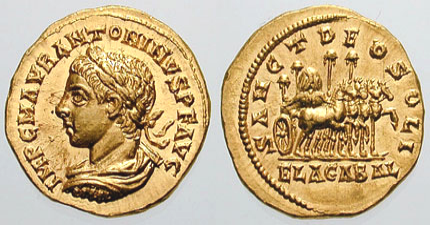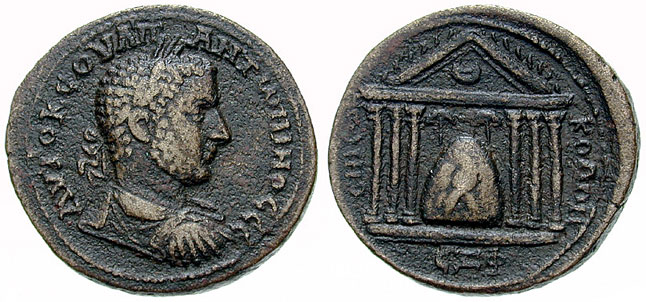 |
| "Elagabalus Aureus Sol Invictus" by Classical Numismatic Group, Inc. http://www.cngcoins.com. Licensed under CC BY-SA 3.0 via Wikimedia Commons |
The reverse of the imperial coin depicts horses pulling a wagon on which there is the sacred black stone from the temple of god Elagabalus in Emesa, modern Homs in Syria.
The stone was associated in Rome with the cult of Sol Invictus by Emperor Marcus Aurelius Antoninus Augustus (c. 203 – March 11, 222). After his death he is commonly known as Caesar Elagabalus according to this his favorite god.
The name is the Latinized form of the Syrian Ilāh hag-Gabal, which derives from Ilāh"god" and gabal "mountain" (compare Arabic: جبل jabal), resulting in "the God of the Mountain" the Emesene manifestation of the deity.
Lenormant, Francois (1881). "Sol Elagabalus". Revue de l'Histoire des Religions 3: 310.
An excellent Wikipedia article tells about this stone and the cult of Elagabalus:
The cult statue was brought to Rome by the Emperor Marcus Aurelius Antoninus, who before his accession was the hereditary high priest at Emesa and is commonly called Elagabalus after the deity. The Syrian deity was assimilated with the Roman sun god known as Sol Invictus ("the Undefeated Sun").
A temple called the Elagabalium was built on the east face of the Palatine Hill, to house the holy stone of the Emesa temple, a black conical meteorite. Herodian writes of that stone:
"This stone is worshipped as though it were sent from heaven; on it there are some small projecting pieces and markings that are pointed out, which the people would like to believe are a rough picture of the sun, because this is how they see them."
Herodian Roman History V,3
Herodian also relates that Elagabalus forced senators to watch while he danced around his deity's altar to the sound of drums and cymbals, and at each summer solstice celebrated a great festival, popular with the masses because of food distributions, during which he placed the holy stone on a chariot adorned with gold and jewels, which he paraded through the city:
"A six horse chariot carried the divinity, the horses huge and flawlessly white, with expensive gold fittings and rich ornaments. No one held the reins, and no one rode in the chariot; the vehicle was escorted as if the god himself were the charioteer. Elagabalus ran backward in front of the chariot, facing the god and holding the horses reins. He made the whole journey in this reverse fashion, looking up into the face of his god."
Herodian Roman History V,3
Herodian's description strongly suggests that the Emesene cult was inspired by the Babylonian Akitu-festival.
Syncretism
 |
| "Bronze-Uranius Antoninus-Elagabal stone-SGI 4414". Licensed under Public Domain via Wikimedia Commons |
The Emperor also tried to bring about a union of Roman and Syrian religion under the supremacy of his deity, which he placed even above Jupiter, and to which he assigned either Astarte, Minerva or Urania, or some combination of the three, as wife.
The most sacred relics from the Roman religion were transferred from their respective shrines to the Elagabalium, including "the emblem of the Great Mother, the fire of Vesta, the Palladium, the shields of the Salii, and all that the Romans held sacred."
He reportedly also declared that Jews, Samaritans and Christians must transfer their rites to his temple so that it "might include the mysteries of every form of worship."
Wikipedia
Meteorite
A 1996 study of the Elagabal stone by Pierre M. Bellamare was published in SAO/NASA Astrophysics Data System (ADS). Titled "Meteorite sparks a cult" it identifies the stone as a meteorite.
The exact origin of the Elagabalus stone remains obscure, but in historical times its destiny was closely interwined with that of a dynasty of king-priests who had been nomads, Beduins of the desert, before settling down in Emesa to erect a shire to Elagabalus. Eventually, the cult became famous and popular, so much that Elagabalus ended up being the chief deity of the Roman Empire under the title "deus invictus Sol Elagabalus," albeit for a short period of time, between A.D. 218 and 222.Because of its apparently huge size the meteorite would be of great interest to modern astronomers. But it is possible that six horses shown in the golden coin were needed to carry not only the stone but the structures emphasizing its holiness. Similarly, the stone shown in the Uranius is hardly in scale with the temple depicted but rather a detailed image of how it looked.
Bellamare 1996 p. 287
Huge meteorites do not usually survive intact in Earth's atmosphere and after the impact on Earth. But the largest known stone from the sky, the Huba.meteorite in Namibia, is a single piece and weights an estimated 60 tons.
In comparison of size, the Black stone in Mecca, al-hajar al-aswed, is 28 cm wide and 38 cm high.
What happened to the stone?
Life of Elagabalus in the Augustan history of uncertain date (4th century?) tells that after the murder of the Emperor in 222, his religious edicts were reversed and the cult of Elagabalus returned to Emesa.
It is possible, as P.M. Bellamare suggests, that the stone was broken by Byzantine Christians. But this is speculation in the lack of any historical or archaeological evidence about the later fate of the black stone
As for the black stone, it was quietly shipped back to Syria and reinstalled in the temple of Emesa. It was probably smashed to pieces when the temple was converted into a Christian church, some time in the 4th century. The site, now occupied by a mosque, has never been excavated. All that remians of the mysterious black stone are ancient texts and a collection of iconographic documents, mostly coins.It might have been smashed into pieces. Or sensing the danger priests of Elagabalus could have moved it somewhere to safety before Christians took over the ancient holy site of the temple.
Bellamare 1996, p. 288